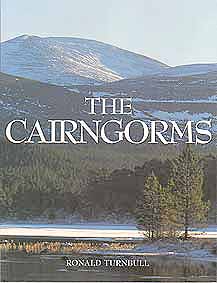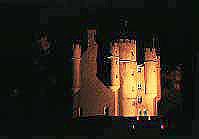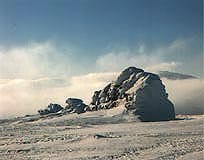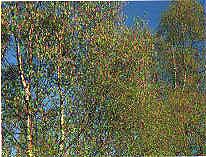 |
|
|
|
|
|
|
|
|
|
|
|
|
|
Pevensey Guide: the Cairngorms
paperback: 250 x 192mm
full colour, with 120 pictures and a map
David & Charles: £10: ISBN 1 85284 342 X
cover: Loch Morlich and Craig a'Chalamain, by Ronald Turnbull
Scotland's magnificent Cairngorm massif, rising to over 1000m and fringed by a large remnant of ancient Caledonian pine forest, is quite unlike anywhere else in the United Kingdom. Destined to become a National Park, this is an area that has been shaped by Nature rather than the hand of man.
Lying in the far eastern corner of Scotland's Highlands, much of this remote granite plateau is inaccessible to all but the hardiest hillwalker and the eagle. But in the surrounding forest, and on the banks of the great rivers and lochs - as well as up the funicular - there is plenty of interest for the discerning tourist all year round: winter snows at Aviemore; a superb range of flora and fauna; the famous summertime Braemar Gathering; autumn colours along the Spey; and, of course, royal connections at Balmoral.
This guide to the Cairngorms and the river valleys that form their boundary - Speyside, Deeside (including Lochnagar and Loch Muick) and upper Donside - will delight and inform every visitor to this fierce but fascinating part of Scotland.
review
as far as I know, this book has yet to attract a review, favourable or otherwise.
|
CONTENTS |
|
Introduction |
|
| 1 |
Eagles to Orchids |
the year in the Cairngorms |
| 2 |
History of the Cairngorms |
|
| 3 |
Badenoch |
|
| 4 |
Glen More |
|
| 5 |
Strathspey and Abernethy |
|
| 6 |
Glen Avon and the Whisky Hills |
|
| 7 |
Down the Don |
|
| 8 |
Upper Deeside |
Braeriach to Braemar |
| 9 |
Lower Deeside |
Balmoral and Ballater |
| 10 |
the mountain ground |
|
| 11 |
walking in the hills |
|
|
end matter |
summary of walking routes
information and places to visit
literary visiting |
INTRODUCTION
CAIRNGORMS - fierce but fragile
Three special sorts of country go to make up the Cairngorms. The great river glens are quite like what you'll find elsewhere in Scotland, only bigger and better. But above the great rivers are the great mountains, and the granite plateau is unique: not just fiercer than anywhere else but also quite different in shape, in layout, and even in its colours of pink and pale grey.
Between the rivers and the hills is the forest. Lochans sparkle between the trunks of ancient pines, and hillsides of bright birch run up to black heather, the snowfields and the sky.
GLENS OF THE GREAT RIVERS
'The Tweed, the Forth, the Tay: the Dee, the Don, the Spey' - these are the streams of Scotland, and the last three are fed by the snow of the Cairngorms. Dee, Don and Spey ripple over banks of granite shingle where the salmon spawn. In Spring the waters are the soft blue of the chilly Grampian sky, and in Autumn the same soft blue is dotted with orange birch-leaves. Soft in colour and slow in flow, these are not gentle rivers. In the days before they were tamed with bridges, the fords and ferries of Spey were reckoned to drown a man a year, while the Dee drowned three. During the nineteenth century the Dee carried away its fine stone bridge at Ballater three times.
 |
This is not the sudden landscape of the Western Highlands, but something more subtle. The mountains lie away in shades of brown heather and grey scree. The wide river valleys (Strath or Srath in the Gaelic) are dotted with small woodlands, middle-sized castles, and world-famous distilleries. Pine trees rise to a small crag, and always somewhere is the glint of the river. It may lack the craggy grandeur of Glencoe or of Torridon, but instead there's a smooth hugeness that creeps up on you. Queen Victoria, who house-hunted the whole of the Highlands, eventually decided on Deeside.
| Margin |
| THE WHITE, THE GREY AND THE PINK |
The original name of the range was the 'Monadh Ruadh' or Red Mount - corresponding with the White Mount, which is the Lochnagar range, and the Monadh Liath (meaning Grey Mount) on the other side of the Spey. The name refers to the feldspar-rich pinkish granite of Cairngorm and Loch Avon. The granite of Lochnagar is lighter; a particularly pale granite was quarried for Balmoral Castle. The Monadh Liath are the grey schist that makes up most of the Central Highlands.
The name 'Cairngorm' was extended from the mountain to the entire range by a guidebook writer called Colonel Thornton in 1804.
|
GRANITE PLATEAU
Unless fate has placed us in the chilly city of Aberdeen, most of us approach the Cairngorms up the wide valley of the Tay. We leave the Lowlands by the bridges of the Forth, or else past Stirling with its city-centre castle. The A9 was built by General Wade for the pacification of the Highlands; and it's a highway of Scottish History.
Above Dunkeld the Highlands close in: pine trees and lumps of grey schist are overhead, the silvery River Tay below. After Pitlochry's tea-shops and tartan there's a tight squeeze through the Pass of Killiecrankie. You see this well from the railway, but if you're in a car then it's best to pull into the National Trust car park for a wander through the oakwoods.
 |
Leaves drip into the river, and match the sad romance of Bonnie Dundee - victorious here on behalf of King James VII (James Two to you English) but all came to nothing when he died of his wounds after the battle. Robert the Bruce also lost a battle here. At Blair you peer through not-terribly-clean Scotrail windows at the striking white castle, or park the car outside the last-chance tea-room, Civilisation's final second-hand bookshop.
For now it starts to get grim. The road climbs, the trees disappear. On either side are bogs backed by slopes of grey heather, and grey cloud is just above. These are the Grampians, where even the Roman Empire petered out in defeat. When you hit the bleak little village of Dalwhinnie you may start to wonder whether to turn left along the A86 to where mountains are mountainous, crags are black, and places have shape as well as texture.
But Dalwhinnie's better than it looks. There's a warm cafe, and the pointy towers of the distillery introduce a much-needed note of levity to the scene. And if you stick with your eastern resolve, things do gradually get less harsh and heathery. A new silvery river - the Spey himself - appears out of grey hills on the left, and above it is the wooded slope where Cluny Macpherson hid out after Culloden and watched the redcoats burn his castle. Meanwhile new hills are rising on the right.
They don't actually look all that important. Even when you get to Aviemore, all you see is a line of flat tops along the horizon, covered in dirty snow, and with a small notch above the footbridge of the railway.
That snow ought to give a clue. Those flat tops are twice as far away as you think, and twice as tall. The small notch is the most famous through-route in Scotland, a wind-filled tunnel of scree and rotten rock, and deeper than most of Scotland is high.
There is craggy grandeur hereabouts: but you're not going to see it from the road or the railway. For this you'll need to penetrate the unique granite landscape of the Cairngorm heartland.
When I wrote my first book of coast-to-coast walks, I needed a special sort of map for the Cairngorms. Everywhere else, mountains were little triangles, and ridges were represented by those black stripes called 'Cathcart Lines'. But the Cairngorms aren't peaks and ridges. They're a wide plateau of boulders and gravel, in all the shades of pink and pale grey, and speckled with lichen. It's a little patch of Arctic transported eight hundred miles to the south, and the weather on Cairngorm summit reaches an international standard of badness.
Out of this plateau the glaciers have gouged deep high-altitude valleys and corries: the Lairig Ghru is the most famous of these, and the hollow containing Loch Avon the most spectacular. Square-topped granite crags, clean but rather holdless, supply sport to the rockclimber and nesting to the eagle. Green pools hang in the hollows, pools that carry ice from October to May.
No motor road runs through - indeed, there aren't even roads right round the edge, as there's a gap comprising Geldie and Feshie. If you get in here at all, it's going to be on foot - or else, if you're Queen Victoria, on a pony. The price of entry to the Cairngorm heartland is several years' experience on lesser hills, and a degree of physical fitness. It's worth the effort...
In the course of the book I hope to take you into this country as far as words and photos can. And at the end I'll be suggesting one or two excursions whereby the reasonably experienced walker can get a first foot onto the granite. There is also the Cairngorm chairlift - or, from Summer 2002 unless it gets delayed, the funicular. The chairlift experience is not altogether satisfactory: it's a bit like being dumped into the concert hall in the middle of the final movement, or having Quark or Netobjects Fusion onscreen when you haven't even been in Windows. The hill-innocent visitor may find it bewildering, and very chilly. The funicular experience, as currently presented, may be even less satisfactory as it'll be a glimpse from the balcony and otherwise entirely virtual and indoors.
| Margin |
| THE ONLY UNTAMED NATIONAL PARK |
In 2002 the Cairngorms are to become Britain's 13th National Park. But in international terms they aren't the 13th but the first and only.
A few paths scratch the gravel of the high plateau; deer have stripped away the trees to leave the mountains huge and bare under the Arctic Winds. In winter, blizzards tear down out of the northeast, covering the valleys with man-high snow and crowning every crag with a cornice to fall through. Sometimes they do the same thing in Summer as well.
National Park status should put a stop to Landrover tracks and other such developments that make the hills effectively smaller - the National Trust for Scotland is facing the expensive task of removing one such track from the very summit of Beinn a' Bhuird. The great pine forests are already being managed back into a semi-natural state, and the National Park will encourage this further.
|
PRIMEVAL PINES
On their way to the granite plateau, hardened hillwalkers whiz along Glen More and head up through the ski area - and thus miss out completely on the third sort of special landscape. The Great Wood of Caledon is not as great now as it was when the Romans named our country after it - 'Caledonia' is Latin Gaelic for 'wooded heights'. But the best of what there still is, is here around the Cairngorms. The high pines grow at Mar and Glen Tromie along the Dee; in the beautiful, empty Glen of Feshie; and most of all at Rothiemurchus and Glen More at the Aviemore end of the range.
 |
Most evergreen trees in Britain are commercial plantations. From a distance they're dull blackish green, and close up a twiggy darkness inhabited by two species of bird and various toadstools.
The Scots pinewoods at the base of the Cairngorms couldn't be more different. They support pine martens and badgers, wildcats and squirrels, crossbills, tits, and capercaillie - and they're good for human beings as well. Wide sandy paths wind through undergrowth of juniper and heather. Sunlight gleams through the canopy, brightening a pile of speckled boulder or a warmly red-brown treetrunk. Behind that treetrunk gleams a lochan, and above the branches the hills rise in shapely heather-covered cones.
Among the dark pines the occasional silver birch stands as surprising as a nude in a nunnery. And there is the clearing, floored with bright bilberry, where pines are old and gnarly. The oldest and gnarliest of these pines, that now look down on picnickers, mountain bikers and the little wooden bothy of Scottish Natural Heritage, watched the last of Scotland's wolves go by three centuries ago.
When it rains on Skye or Lochaber, you choose between improving your mind at some ancient monument or addling it with alcohol at the distillery. Speyside too has history and whisky. But bring your waterproofs as well: for a wet day is well-spent in the Rothiemurchus Forest. The wind lashes the treetops, and the clouds above seem intent on breaking every record by running across Scotland coast-to-coast in under three hours. But down on the sandy forest floor the air is scented with resin, and there are dry spots below the branches for a lunch stop. A gap opens, and the lochan is frothy with white waves; the castle on its island drips and is grim.
That's on a bad day. But on Autumn mornings mist drifts across the water, and the birches are orange flame against the face of the hill. In crisp Winter, spindrift blasts between the boulders under a piercing blue sky, and from the plateau edge you look out across brown lowlands and forty miles of sea to the snow peaks of Caithness. Two months later, Spring scatters golden light across the forest floor. In the treetrunk shadows lurks the memory of the brigand and the bear, and the fairies are washing their green garments in the waters of Lochan Uaine...
Each of these - the great river valleys, the granite plateau, the primeval pinewood - is unlike anywhere else in the UK. The combination is the Cairngorms.



